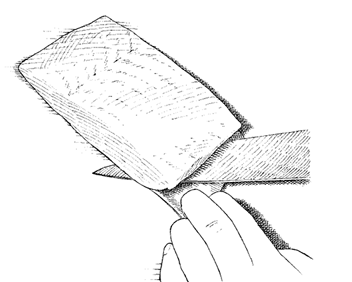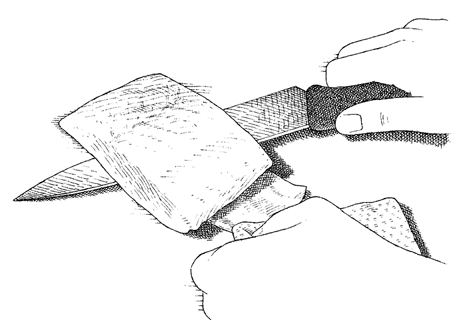The Cook's Illustrated Cookbook (200 page)
Read The Cook's Illustrated Cookbook Online
Authors: The Editors at America's Test Kitchen
Tags: #Cooking

MAKES ABOUT
1¹⁄
2
CUPS
Rubbing the toasted hazelnuts in a kitchen towel is an easy way to remove their skins.
¹⁄ | cup hazelnuts, toasted and skinned |
¹⁄ | cup jarred roasted red peppers, rinsed, patted dry, and chopped coarse |
1 | garlic clove, minced |
¹⁄ | teaspoon grated lemon zest plus 4 teaspoons juice |
¹⁄ | cup extra-virgin olive oil |
2 | tablespoons chopped fresh parsley |
1 | teaspoon chopped fresh thyme |
¹⁄ | teaspoon smoked paprika |
Salt and pepper |
Pulse hazelnuts, roasted peppers, garlic, and lemon zest in food processor until finely chopped, 10 to 12 pulses. Transfer to bowl and stir in lemon juice, oil, parsley, thyme, and paprika. Season with salt and pepper to taste.
If you happen to buy skin-on fillets, some quick knife work can remove it.

1.
With sharp knife, separate corner of skin from fish.

2.
Using paper towel to hold skin, slide knife between fish and skin to separate them.
![]() WHY THIS RECIPE WORKS
WHY THIS RECIPE WORKS
To have the fish and sauce in our sautéed fish fillet recipe ready to serve at the same time, we used fillets of uniform size, between ¹⁄
4
and 1 inch thick, small enough so that four fillets could fit in a skillet. We reversed the cooking process specified in most sautéed fish fillet recipes, making the sauce first and keeping it warm in a separate saucepan while cooking the fish.
See “TUCKING THE FILLET TAIL” illustrations that follow recipe.
SERVES 4
When it comes to the size of a fish fillet, there are two general categories: thick and thin. Thickness determines in part how long the fillet must be cooked. Do not use fillets thinner than ¹⁄
4
inch, as they will overcook very quickly. These fillets are good served simply with lemon wedges, or you can prepare them with a sauce (recipes follow).
¹⁄ | cup all-purpose flour |
4 | (6-ounce) boneless, skinless fish fillets, ¹⁄ |
Salt and pepper | |
2 | tablespoons vegetable oil |
Lemon wedges |
1.
Place flour in baking dish or pie plate. Pat fish dry with paper towels. Season both sides of each fillet with salt and pepper; let stand until fillets are glistening with moisture, about 5 minutes. If using any tail-end fillets, score and tuck tail under. Coat both sides of fillets with flour, shake off excess, and place in single layer on baking sheet.
2.
Heat 1 tablespoon oil in 12-inch nonstick skillet over high heat until shimmering. Place half of fillets in skillet in single layer and immediately reduce heat to medium-high. For thick fillets: Cook, without moving fish, until edges of fillets are opaque and bottoms are golden brown, 3 to 4 minutes. For thin fillets: Cook, without moving fish, until edges of fillets are opaque and bottoms are lightly browned, 2 to 3 minutes.
3.
Using 2 spatulas, gently flip fillets. For thick fillets: Cook on second side until thickest part of fillets is firm to touch and fish flakes easily, 2 to 3 minutes. For thin fillets: Cook on second side until thickest part of fillets is firm to touch and fish flakes easily, 30 to 60 seconds.
4.
Transfer fillets to serving platter and tent with aluminum foil. Repeat steps 2 and 3 with remaining 1 tablespoon oil and remaining fillets.
5.
Place second batch of fillets on platter with first batch; tilt platter to discard any accumulated liquid. Serve fish immediately with lemon wedges.
SERVES 4
For those who like assertive flavors, the amount of red curry paste can be doubled; in this case, be conservative when seasoning with salt and pepper. Make sure to prepare the sauce through step 1 before cooking the fish.
2 | teaspoons vegetable oil |
2 | teaspoons minced fresh ginger |
2 | teaspoons red curry paste |
1 | small garlic clove, minced |
¹⁄ | teaspoon brown sugar |
1 | cup coconut milk |
3 | tablespoons water |
1¹⁄ | tablespoons lime juice |
2 | teaspoons fish sauce |
1 | tablespoon chopped fresh cilantro |
Salt and pepper | |
1 | |
Lime wedges |
1.
Heat oil in medium saucepan over medium heat until shimmering. Off heat, add ginger, curry paste, garlic, and sugar and cook, stirring constantly, until fragrant, about 30 seconds. Add coconut milk, water, lime juice, and fish sauce. Increase heat to high, bring sauce to boil, and boil until sauce is reduced to about 1 cup, about 3 minutes. Off heat, stir in cilantro and season with salt and pepper to taste. Cover to keep warm and set aside, stirring once after about 1 minute, while preparing fish.
2.
Stir sauce to recombine and spoon ¹⁄
2
cup over cooked fish fillets. Serve immediately with lime wedges, passing remaining sauce separately.
SERVES 4
Remove all white pith and membranes from grapefruit sections destined for garnishing the fish. Make sure to prepare the sauce through step 1 before cooking the fish.
2 | tablespoons grapefruit juice plus 1 grapefruit half, cut into sections |
2 | tablespoons lime juice |
1 | shallot, minced |
1 | teaspoon honey |
6 | tablespoons extra-virgin olive oil |
1 | tablespoon chopped fresh mint |
1 | tablespoon chopped fresh chives |
Salt and pepper | |
1 |
1.
Combine grapefruit juice, lime juice, shallot, and honey in bowl. Whisking constantly, gradually add oil. Add mint and chives and season with salt and pepper to taste. Set aside while preparing fish.
2.
To serve, whisk vinaigrette to recombine. Drizzle vinaigrette over cooked fish fillets and serve immediately with grapefruit sections.
SERVES 4
We like the delicate, fruit flavor of champagne vinegar in this sauce, but white wine vinegar can also be used. Make sure to prepare the sauce through step 1 before cooking the fish.
2 | teaspoons vegetable oil |
1 | shallot, minced |
1 | cup orange juice |
3 | tablespoons champagne vinegar |
¹⁄ | cup heavy cream |
2 | tablespoons unsalted butter, chilled |
1 | tablespoon minced fresh tarragon |
Salt and pepper | |
1 | |
Orange wedges |
1.
Heat oil in medium saucepan over medium heat until shimmering; add shallot and cook, stirring frequently, until softened and beginning to color, about 1¹⁄
2
minutes. Add orange juice and vinegar, increase heat to high, and bring to boil; boil until reduced to ³⁄
4
cup, 4 to 6 minutes. Add heavy cream and continue to cook until slightly reduced, about 1 minute. Off heat, whisk in butter and tarragon, and season with salt and pepper to taste. Cover to keep warm and set aside, stirring once after about 1 minute, while preparing fish.
2.
To serve, stir sauce to recombine and spoon ¹⁄
2
cup over cooked fish fillets. Serve immediately with orange wedges, passing remaining sauce separately.
SERVES 4
One tablespoon of lemon juice is cooked into the sauce; an additional tablespoon can be added later, if desired, for a bright, tart flavor. Make sure to prepare the sauce through step 1 before cooking the fish.
2 | teaspoons vegetable oil |
2 | large shallots, minced |
¹⁄ | cup dry white wine |
1–2 | tablespoons lemon juice plus lemon wedges |
4 | tablespoons unsalted butter, chilled |
1 | tablespoon capers, rinsed |
1 | tablespoon chopped fresh parsley |
Salt and pepper | |
1 |
1.
Heat oil in medium saucepan over medium heat until shimmering. Add shallots and cook, stirring frequently, until softened and beginning to color, about 1¹⁄
2
minutes. Add wine and 1 tablespoon lemon juice, increase heat to high, and bring to boil. Boil until reduced to ³⁄
4
cup, 3 to 5 minutes. Off heat, whisk in butter, capers, parsley, and, if desired, remaining 1 tablespoon lemon juice until combined; season with salt and pepper to taste. Cover to keep warm and set aside, stirring once after about 1 minute, while preparing fish.
2.
To serve, stir sauce to recombine and spoon ¹⁄
2
cup over cooked fish fillets. Serve immediately with lemon wedges, passing remaining sauce separately.
